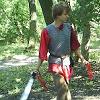Search the Community
Showing results for tags 'PF'.
Found 253 results
-
MOD - 12 volt wheels with axle hole for Power Functions motor
Paperinik77pk posted a topic in LEGO Train Tech
Hi all, since 7777 book came out, I've always wanted to integrate Trains and Technic worlds. Back in the 80's the problem was the complete lack of train wheels with a Technic axle hole. It was solved with RC trains a lot of years later. Therefore, I can convert a 9v train to PF without too many problems (aesthetically speaking). But for 12V trains it is different. Wheels are made in a specific way, they have the hole for connecting rods, they're more "fat" than RC/PF wheels. Frankly, I do not like 12V trains converted to 9V/PF standard bogies. But I like the PF motor, its speed, the possibility to increase speed gradually...and the fact it keeps the central hole for third wheel. So, in these years I repaired a lot of 12V motors...and some were really in bad shape. Look at the right wheel, it is completely destroyed inside. So I decided to try to implement my solution to connect standard, intact 12V wheels to technic axleholes (which I do not list here, since it was not satisfying). First, I got a standard Technic bush, and cut it a bit. Then I put it inside the damaged wheel hole. It fits fine, but needs to be glued. Once glued, it is time for some testing. The 6-long axle goes right in - but the red ring coming out from the wheel is too thick. So I prepared another wheel (gray bush). This time I cut the bush a bit shorter and fits right. The 5.5 axle is perfect , so I'll need to cut two 6-long axles to the right lenght. And this is the result - this is my 7740 no°3, totally converted to PF. It works fine, but as you all can imagine, it is all made by hand and bushes are not machinery-centered. Therefore the locomotive is not stable as I would like. For the moment, better than nothing! -
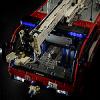
[MOC] Crane Truck
Lucio Switch posted a topic in LEGO Technic, Mindstorms, Model Team and Scale Modeling
Hi to everybody! I'm here to present my new Moc. I started building this crane truck about 6 months ago with the main idea of solving the problems related to a failed attempt of a crane for my previous truck. IMG_1608 by Lucio Switch, su Flickr Starting from the cab...despite the undeniable resemblance to the cab of the dump truck (with a bit of the tractor truck), it has slightly different dimensions, and the add of some new details/functions, forced me to revise it completely. In fact, in addition to the "standard" opening doors, this time, as on real trucks, the cab is suspended, while maintaining the tilting function and the working steering wheel and the front grid is openable. Moreover the seats are pneumatically suspended via 2 (1+1) 1x5 pneumatic cylinders. The chassis has the tractions on the 2 last axles, they are driven by 4 XL Motors and uses 2 Servo Motors to steering the first two axles (with different turning radius). The first two axles use independent suspensions. In this case I was inspired by the Mod of the chassis of my Tractor Truck done by Efferman ... that has a perfect shape for a fake v8. On the back there are 2 live axles (with a total of 24 hard shock absorbers). Between the first two axles there are two small pneumatic pumps moved by two L Motors. In addition to that, on the chassis are present 2 Li-Po Battery, 5 Leds for lights and 2 SBricks. Behind the cabin there is the base of the crane, it contains the front stabilizers, extendable via a M motor (connected to one SBrick), 6 pneumatic valves, moved by an M motor each, 4 IR receivers to control the 6 valves motors plus 2 other M motors, one to rotate the crane and one for the winch. The 4 receivers take power from a port of an SBrick. Finally the crane ... well, the classic design of this type of crane with the upper arm offset (as on 8258 for instance) built on this scale, gave me big problems twisting the whole structure ... and a lot of headaches. One day I came across by chance in a truck with a Cormach crane, it presented a unique design that would solve the twist problem. So inspiring to this design, I have developed my crane, which consists of a telescopic upper arm (extension via 2x 1x11 pneumatic cylinders) supported by two side arms moved by 2+1 2x11 pneumatic cylinder each. It isn't able to lift heavy loads, but it works and, considering the masses involved, I'm fine with that. Now some numbers: Length: 86,4cm 108studs Width: 24,8cm 31studs, 28cm 35studs with mirrors Height: 39,2cm 49studs Weight: 8.6 kg Total number of parts: 8000 PF elements: M motor: 9 L Motor: 2 XL Motor: 4 Servo Motor: 2 PF LED: 5 Lipo Battery: 2 ..and a couple of wire extensions Pneumatic Elements: Small pumps: 2 1x5 Cylinder: 2 Medium Cylinder old: 4 Medium Cylinder new: 2 1x11 Cylinder: 2 2x11 Cylinder: 6 Valve: 6 ..and several meters of pipes. For more pictures check my Flickr Album: Crane Truck Flickr Album And this is the video: To conclude, I would say that, in some way it was a new and interesting experience for me. Due to circumstances beyond our control, I was forced to transfer my Lego room in the basement, comfortable although perhaps a bit rustic but not directly connected with my apartment. This, coupled with the fact that my free time has been drastically reduced, has led me to review my usual workflow. So this is my first model built before digitally and then physically. This way allowed me to use better my free time and to select and pick up only the needed parts to build, reducing drastically the mess in the living room. Also part of the work for the BI is already done, I'll done them for sure, but I don't have idea when they will be ready. I'm afraid that it will be a huge job! I hope you like it! -

[TC6] Hyster 32-12 Forklift truck
TheItalianBrick posted a topic in LEGO Technic, Mindstorms, Model Team and Scale Modeling
Hello, my entry for the TC6 contest it's a heavy forklift truck, the Hyster 32-12. The model has 8 functions (4 IR or 2 sBricks), it's 50% built at the moment and nearly completed on LDD/MLcad. Soon I'll put updates (photos, video, notes) Here a pic of what an Hyster 32-12 is: Thanks, and hold on for news. Video: -

SBrickPad (SBrick-Controller) for iOS progress update
BarakRL posted a topic in LEGO Technic, Mindstorms, Model Team and Scale Modeling
Updated: The (almost) final version of the app is ready, app renamed to SBrickPad. For now, you can download the source from my GitHub page: https://github.com/BarakRL/SBrickPad If there will be enough demand I'll make it available for download from the App Store. The app supports MFI and iCade gamepads, on-screen gamepad will be added later this month. More videos coming soon. --- Well it's not done yet but it's getting there. I've added support for both iCade and MFI gamepads and many other features: precision controls (you can even set the easing curve if you want) SBrick connection recovery multiple actions per button event (press/release/value change) so you can control multiple motors with one button or simply play an engine sound while the car is accelerating load/save (and share) action sets import sounds many other things I can't think off right now Do do: Edit actions UI (you can now only edit the json file) On screen virtual gamepad (so it can replace the SBrick app for people without gamepads that still want more control) Make it pretty Documentation etc. The app is still in development, but the source is available to download from my GitHub if you want to play with it already: https://github.com/BarakRL I would love to hear your feedback! -
So I ran into a problem I couldn't solve on my own but reduced the possible error to the PF train motor. I have three, differently colored, but in dimensions and structure identical Stadler FLIRT electric motor units built from LEGO bricks. All three of them are powered with SBrick, using three PF train motors under each train. Here they are: I noticed that the yellow-green one runs slower than the other two, the speed difference on the same level of SBrick slider is very noticable, and there is a speed level when the yellow stops, but the other two runs on multiple curves and points with no problems. For first I thought that it could be the failure of the oldest SBrick in my yellow train, but when I replaced it with a new one, nothing happened. I measured output voltage on the output reserved for train motors, but it was just fine, only 0,02V less than the actualy batteries had. Than I replaced train motors, all three to brand new ones and the train became even slower. Than I replaced all PF extension wires between battery box and train motors, still runs slower. I measured the weight of the train, but they are 3882 and 3814 grams, the difference is only 68 grams (the yellow-green is heavier)., this is no explanation for the speed difference. Than I put the new train motors under the red one and it became slow as well. It is also noticable that a train with new motors is harder to push by hand than the train with older ones. So, my question is, did TLC change something in the internal gearing and other properties of the LEGO train motor? Neither Bricklink, not Brickset knows about the difference (if there is any), and the PF train motors has no production year printed on them, just "(C) 2005 The LEGO Group" on the bottom and a four digit code at one end, like XX JX, where XX is a two digit number, J seems constant (I checked 10 train motors), and the X after "J" seems increasing with time (my oldest motors have J0, J1 or J2, while newer ones have J4, J5, J6 underneath). The XX digit seems totally random. So does anyone know about any change in the inside parts of the PF train motor and could you advise me a method to select the faster ones?
-
Hi all, I'd like to show you a little thing I made 6 years ago for my daughter...and then became unused on the shelf since it was "retired" by Duplo trains. It was a sort of DB E69, used to transport frogs and penguins (all made with Lego Basic sets instructions). After she saw the real 7720 she liked the whole set. So I created a newer "clone" of the 7720 locomotive. This weekend I decided to revamp it a bit to make it work again. So I modified the roof, the handrails, the pantograph (which now is very similar to swiss ones) and made it a bit more "studless". The battery car is now blue instead of Yellow. It was - and still is - powered by a Medium PF motor, since it was not Infrared controlled and the standard PF train motor was too fast. Instead of IR receiver, it kept a "vintage" solution to be started. I used the PF lever the same way the 7720 used the red lever on battery box car. The IR receiver can be put inside the battery car if needed. As you can see, I have the same 7720 inverters placed on PF track...and the result is the following (sorry for the video quality, the phone cannot do better than this). The cat likes this "reversing" feature a lot! Next steps: two long two axles wagons resembling the 7720 ones, and the white doors on blue wagon created in SNOT mode (or a simple sticker, if I fail ) It is a silly train, but I hope you like it!
- 19 replies
-
- power functions
- pf
-
(and 3 more)
Tagged with:
-

Powering PF from AC; any advice?
fred67 posted a topic in LEGO Technic, Mindstorms, Model Team and Scale Modeling
So I know that, in this forum, most of you are concerned with mobile models that require a battery to use, but I also figured this would be the best forum to ask these questions as the people here seem more likely to know about stuff like this. In order to not have to build around a battery box, I've been using 9v batteries and one of these: And it occurred to me that, for my table top PF builds (in this case a track switcher for trains, or an elevator in a building), I could have an AC power adapter wired to a PF connector. So I'd buy a PF extension, cut it in half, and connect it to these: https://smile.amazon.com/gp/product/B01GPQZ4EE/ (female adapter cables) and https://smile.amazon.com/gp/product/B012VQ5A7S/ (9v DC Adapter, 1000mA with 5 male plugs) I could instead get a 500mA adapter, but I figure AAA are 1000mA, and have been using the AAA battery box). -

[Poll] Power Functions 2.0: receiver or no receiver?
Trekkie99 posted a topic in LEGO Technic, Mindstorms, Model Team and Scale Modeling
What's your opinion on Power Functions 2.0, and the potential that we may or may not have a separate receiver unit for the new system? Do you want a separate receiver unit like what we have currently, or do you want a combo unit composing of both a receiver unit and a battery box? Also, how important is a separate receiver unit to you? (Shoot. It appears the poll isn't working.) My personal opinion is the following. 1: Sort of. 2: Sort of. 3: Sort of necessary. -

[MOC] LEGO Forwarder XXL
morson1 posted a topic in LEGO Technic, Mindstorms, Model Team and Scale Modeling
Hi all, A little presentation of my LEGO Forwarder named XXL for obvious reasons :) It has been a project in my spare time for some years now and still not finished (probably never will be...) Most basic facts: Weight: 6,7 kilograms Dimensions: 95xx36x50 studs Drive: 8 XL motors + hub reduction Steering: Forced by controlling front left with rear right and the other way around (because of the weight in combination with the huge friction from the wheels) Wheels: From 8466 (4x4 Offroader) Some vids from Youtube: Feel free to comment or ask questions, I´ll try to answer them :) -

[MOC] Front Loaded Garbage Truck
Waler posted a topic in LEGO Technic, Mindstorms, Model Team and Scale Modeling
Hello everyone It’s good to have some spare time but better that sitting on the couch is to present one of my last MOCs – Front Loaded Garbage Truck. The truck was made almost three months ago (but I done it from scratch in 8 days!) for our local LUG contest. The goal was to made something up to 2000 pieces and maximum of 4 engines. I thought that front loaded garbage truck could be a nice playable model and I haven’t seen much of them made from Lego. The truck of course fit to rules so it has a four remote functions like: - driving and steering - lifting arms - moving front forks In addition to electric functions there are two pneumatic (with manual pump) – dumping the whole body and opening tailgate. If you want more accurate specification: Weight: 1700g Dimensions: 19 studs wide, 22 studs high, 53 studs long (15.2x17.6x42.4cm) Parts: almost 1900 The truck is designed to emptying big waste bins. Whole process don’t take much time. Lifting functions are motorized so you don’t have to even touch a truck to dump wastes into body. Lifting the arms are operated by L motor connected to two big linear actuators. For moving forks I used a M motor and built a long shaft through arm to connect small LA’s. Each small linear actuator is driven by 6 universal joints. Maybe it don’t sound good but I have to say that everything works fast and fine. First you have to do is drive up to waste bin. Then lift it above body using arms. Meanwhile flap mounted on top of body opens itself and then you roll over waste bin with front forks. When bin is empty simply lower arms and put it onto ground. For driving I used XL motor with total gear reduction 1:1.4 That ratio gives you an opportunity to push truck by hand (and engine will turn). Steering is simply operated by PF Servo. As I said at the beginning there are two pneumatic functions. For opening tailgate I used one small pneumatic cylinder and for lifting body – two big cylinders. Lowering body and tailgate is done by gravity – there is no need to use air pressure. For more playability I made two waste bins – green and red. Maybe this is not a masterpiece but it had to be light. So what say more? I think that movie will say everything that possibly I forgot to write :) -

Drive Train for Heavy Treaded Vehicle
mxp posted a topic in LEGO Technic, Mindstorms, Model Team and Scale Modeling
Hi Everyone, I have a pretty heavy model that I would like to put on treads. The final model will probably weigh something around 12-15kg. The model is also supposed to move at a certain speed (around 10cm per second). As a result I think I will need to combine several PF XL motors to get the necessary torque and speed. In my opinion I have 2 options: Option 1: Adders + Subtractor I would connect several PF XL motors via adders for torque and then a subtractor for steering. I think I would need to heavily (9:1) gear up each motor before the differentials because the small 12 tooth bevel gears in the differentials (for adders and subtractor) don't handle torque very well. So I would first gear up and then, behind the subtractor gear down, so that I get more torque again. Advantage: Model can go straight (thanks to the subtractor); No hard-coupling (motors won't suffer) Disadvantage: A lot of power from the motors gets lost because there are so many gears. I'm not sure how fast lego gears and axles can spin for a long time without breaking (PF XL motor 200rpm with 9:1 gear up = 1800rpm) Option 2: Several PF XL motors on each tread I would have multiple sprocket wheals for each tread that is driven by a PF XL motor. Advantage: Simpler construction; less power loss Disadvantage: Hard-coupled motors (coupled through the tread links); model never goes straight because all motors won't turn at exactly the same speed. My question is, do any of you have experience with very heavy treaded models? What's the best way to drive them? (so that they can go straight) How many PF XL motors would I roughly need for a 12-15kg model? Thanks for your help and let me know if my description of the problem doesn't make sense :) -
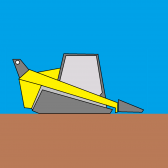
Mobile Crawler Trencher (MOC)
Aventador2004 posted a topic in LEGO Technic, Mindstorms, Model Team and Scale Modeling
Edit, repaired post. Wow, how far i have come... **WARNING LONG POST** One of my largest creations yet: the Mobile Crawler Trencher! My goals: Reliable, kid friendly structure Easily carried Battery and motor (AA and M motor) Tracked, very slow and powerful Clutch gear (24z) and a reversible gearbox. Kid friendly speed, not enough to hurt (it makes it easy to stop, so it wont trench any hard things) Easily removable battery I am happy to say, all goals were accomplished. I believe 3 full days were spent constructing it, then i tinkered to get it just right. I got three opinions on it, all were positive so far, i hope you enjoy looking or commenting on it. I will not post a picture of any other trenchers, because i didn't take much inspiration from them. The features: Motorized: 2 function, reversible gearbox Driving tracks (forward only (1:15 gears) Bucket trenching spikes + sifters M motor geared 1:3 through a clutch gear (24z) Others: Guardrails Driver area (Left side) Lifting or lowering the bucket wheel Well, now the interesting part of all. Easily seen operator areas. Control area. Battery removal and reversible gearbox. Enjoy your day, or post away! -
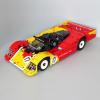
Truck Trial Mercedes Uniknick
Tamas Juhasz posted a topic in LEGO Technic, Mindstorms, Model Team and Scale Modeling
I present my newest trial truck, a pretty special one, this Mercedes Uniknick: (folder: http://www.brickshel...ry.cgi?f=515930 ) ORIGINAL: http://www.brickshel...spiration02.jpg This construction has central steering, this allows to have only one gear from the driving motors to the wheels. Reduction is 5:1, or 3:1 (has enough torque with it). I didn't want to make an average central steered vehicle like dump trucks, so I decided to add something new. One of the problems was the stability. This kind of off road vehicles like to fall over, that's enough when one section(front or rear) is turned 90 degrees. So this one has a linked like suspension, but with gears and turntables instead of links( not my idea, TT made it in this truck: http://www.brickshelf.com/cgi-bin/gallery.cgi?f=444654 ): So this construction allows to do these at the same time: There is two version from this truck, one with PP wheels(secondary version) and the one with cutom RC4WD crawler tyres(primary model). The PP wheeled truck weights 1767 g, the crawler wheeled 1423 g. I know, it looks much better and realistic with the RC4WD tyres, that's the main reason I used them. The tyres give a bit better climbing abilities (PP wheels are still good), the highest obstacle was 1,5 times bigger than the wheels's diameter. For steering there is one XL motor to have enough power to do it. It's necessary because of the 16 t turntable driving gears, there are two of them, one on each side to make the steering reliable. There weren't any problem with it. Front lights: The hardest part in the building process was to make the central part, to be reliable and functional with keeping the proportions of the original Uniknick. I made a video for each version. Note the PP wheels abilities compared to the crawler tyre. RC4WD Crawler wheel: PP wheel: Hope you like it.- 21 replies
-
- TT
- truck trial
- (and 4 more)
-
This is a fully functional prototype of a brick (2 x 4 x 1) that we developed to make it easy to control PF motors with Arduino boards. It has a PF connector on the top to connect the PF motor and a 4PIn cable to connect to the Arduino board; it has 8 anti studs on the bottom to connect it to LEGO bricks. It allows controlling the direction and speed of the PF motors. We tested it with the M-motor, L-motor, XL motor and the train motor. This is the brick in action with an M-motor: Let us know what you think or what you would use it for!
-
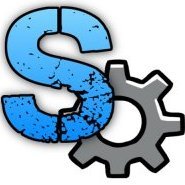
[MOC] Security camera
blaz62 posted a topic in LEGO Technic, Mindstorms, Model Team and Scale Modeling
Hello everyone Today I will show you my new creation, security camera. This is a little different creation. It is build from 99% Lego bricks. Only non Lego part are phone (Sony Xperia S), camera (Sony HDR AZ-1) and batteries. Camera is powered by 2 M motor, one for rotation and one for tilt. Phone and camera are connected via Wi-Fi. VIDEO: -
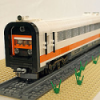
[VIDEO] Trenbrick 2017 RENFE R104 Circuit + Narrow Gauge
mtrkustoms posted a topic in LEGO Train Tech
Hi to all, Here is a short video of the last event I participate with All spanish replicas of Renfe from Aitoruco and myself. 2 diferent loops with r104 custom curves (printed by blastem), 20Bps cable bridge (Designed by Sheppo), R104 trains (designed by Aitoruco and MTRkustoms) and also working narrow gauge (by MTRkustoms) Enjoy it -

[WIP] 1:50 NASA Crawler Transporter
OzShan posted a topic in LEGO Technic, Mindstorms, Model Team and Scale Modeling
I am getting close to the end of this long term build and it's time to share some pictures and a bit of the story. Even before I had finished putting together 10231, I decided I wanted a Crawler to go with it. Being a Technic fan it had to at least drive around and lift the launch platform and shuttle. Those two basic goals spawned a project that has lasted a little over 2 years so far. Some ideas have stuck around since their inception, others were a bit optimistic (like building a peristaltic pump and hoping I could find a way to control the pneumatics hydraulically). February this year marked the 50th anniversary of when the two crawlers went into service, so recently there has been extra motivation to finish. The base equipment; - 16x M-motors (drive) - 4x L-motors (pneumatic jacking and leveling) - 4x IR Receivers (V1 as the V2s do not like driving multiple m-motors on a single channel) - 4x NXT servo motors (steering) - 4x RCX rotation sensors (measuring jacking level between truck and chassis) - 2x NXT bricks (one master and one slave. The master communicates with the Android Tablet and coordinates itself with the slave. Programmed in LeJOS) - 1x PF IR-Link sensor (link between master NXT and all PF motors) - 2x PF Battery boxes (with thermal overload removed) - 1x Android Tablet Future add-ons - Accelerometer (automatically detect the crawler is on a gradient and adjust the leveling to suit) Bricksafe folder is here: http://www.bricksafe.com/pages/OzShan/Crawler Firstly, a couple of my favorite reference pictures; The build itself started with the trucks, thinking that the pneumatics and LAs would dictate the scale. First proof of concept - build a coupling to give height, pitch, roll and yaw to the truck. The pneumatics need to be on their own gimbals too. The reinforced 2x2 rounds slide and rotate in the 4x4 macaroni's. It is on the limit of what will hold together without glue, but it does hold. The two 1x2 technic bricks at the base of the 2x2 column are helped a little by a string (not pictured) which runs up through the 2x2 rounds with the axle. Initial prototype of the drivetrain. I would have liked a higher ratio but there was just no room at this scale. When the gearbox was married with the truck chassis I had to juggle positions, so you will see in later pics the crown gears are facing in not out Best laid plans.... Marry studded and studless they said. It will be easy they said... Showing what will eventually be the steering between chassis and truck. The guide tube and pneumatic cylinders are all on gimbals with the pneumatics coupled together. The average height is preserved during any tilting. With prototypes sorted, it's time to bricklink some parts and quieten down the colour scheme! (thank you 42030 for providing 5L thin liftarms with axle hole in LBG color) You can see the relationship between "guide tube" and cylinders here. The pneumatic system was overhauled too many times to remember but this is what it arrived at. It is all controlled by the direction of the motor. Running forwards drives the pump. When running backwards, the lobes operate the pneumatic valves in series, letting small amounts of air escape each rotation. This lowers the chassis in a slow and controlled manner. The motor can be turned on or off and run in either direction at any time due to the valve timing. Early attempts with PF Servo and NXT servo just couldn't park the valve reliably and after a few operations I would hear a slow leak. I have been trying to keep up with the LDD but it's hard to stay motivated when I know I'm just going to have to suck it up and move over to LDraw if I want to include all the motors, pneumatics and LAs Works so far; (I'll make the files available if anybody would like them). I found LDD essential in the early days to plan ahead and simply find parts, but later on the build overtook it. Original 'box' pump. 1x PF XL motor, 4x 6L pumps running at 90 deg to each other. Very smooth but bulky. Flatter attempt in the same vein. The truck itself. The final design for the height control modules. I hope you enjoy the build so far. More pictures to come of chassis, steering, leveling and interior details. I'll leave it to others to decide what 'theme' it belongs to .- 73 replies
-
- Power functions
- NXT
-
(and 5 more)
Tagged with:
-
.thumb.gif.ad7c8d88b264ee812194946c07404504.gif)
[TC12][MOC] The Banana Scorpion
mocbuild101 posted a topic in LEGO Technic, Mindstorms, Model Team and Scale Modeling
Question: What do you get, when you cross a tank, with a banana, a scorpion, a V8 engine, and a bunch of stud-shooters? Answer: The Banana Scorpion! Color scheme: Yellow, with some black and grey. Driver: A Big Giant Banana-eating Tiger! (this one) Powered Functions: Drive: Tank tracks - powered by 2x M-motors. (also used for steering) Steering: Tank type skid steering. Engine: A massive V8 - powered by a high speed motor. Wacky function 1: Lifting hull mechanism - powered by M-motor. Wacky function 2: High speed spinning sweeper - powered via V8. Wacky function 3: The ability to tank-wheelie!!! (with some help...) Manual Functions: (aka: weapons) Cannon: A giant cannon mounted on the end of the adjustable scorpion tail. Stud-shooters: Front: 2x six-round, and 2x single-round - Rear: 4x single-round. Spring-shooters: 2x rear-mounted. (can be triggered by driver) The story of how The Banana Scorpion was built: -
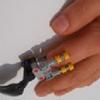
BMW vision M power
9 fingers posted a topic in LEGO Technic, Mindstorms, Model Team and Scale Modeling
Hello everyone. After a very long time, I would like to present you my new creation. Its a BMW vision M power. As you will see later, the vehicle has no special features, since from the very beginning, the idea of building was primarily in the design and form of the car. The idea was of a typical character in the BMW style. A kind of prestigious futuristic retro sports style with recognizable BMW lines. PF components are: - 2 L motors for drive - 1 servo motor for steering with funtcional steering wheel - 1 M motor for 3 speed linear gearbox. It was the worst decision and design in my life for this gearbox.When I built and tested, it all seemed to work wery good.Now it is finished and definitely a total breakdown. After eight months of building this car, I simply do not go all over and repair it all. There is no chance. - 2 V2 recievers - 1 big batery box Some pictures. And my favorite photo. And the video. Thanx for watching. Best regards, Valter -

Mini Dumper with BuWizz
teflon posted a topic in LEGO Technic, Mindstorms, Model Team and Scale Modeling
I had a long conversation with Roni of BuWizz fame about desirable vehicles used with his invention. Apart from electrifying large Lego technic vehicles, we were thinking about producing a simple and low-part-number vehicle, which can be quickly build and used. Well, this was the intention, however I was not very successful with this. I mean, it's not a problem regarding dimensions etc., but more of a general shape. My cars look like something from another world but not in a good sense. So, please Sariel and other well established builders, perhaps you could just skip this presentation:-) But then I have spotted Mini Mining Truck in 42055 and it seemed cute (perhaps I am a bit biased towards large models but small technic models are generally quite nice and full of features). Therefore I decided to motorized it. At first I've tried with Lego components but found out there is no room. Then I decided to use BuWizz, since allowed a bit smaller footprint. However, the truck kept growing in size. I have motorized the propulsion (I wanted to add the differential, however it kept the truck to slip while navigating rough terrain), steering and raising/lowering the dump. In addition I have also put in some lights, however BuWizz application at this moment does not support switches (hint, hint) so using lights is a bit of a drag. There are several issues I did not addressed properly: single back wheels (not enough room at this scale), not uniform color (lack of parts), cabin missing (I used the space for cables) etc. I have rebuild the d*mn thing at least 10 times but I guess this just speaks about my inability to do great technic job. Nevertheless, the truck moves and it's quite fun to play with. And I guess this is one of the main features. -
Hello everybody and let me present my version of a modified 42005 Monster Truck. It was my second set after my "dark age", that I've bought many years ago, after 42029 as supplementary set with a lot of useful pieces and planned to use for a live axle suspension and some other features for 42029 model. However, I liked the set as a simple and functional model and re-assembled it several times. Here is the model and later I'll provide the all details: A month ago, when I tired of infinite attempts to turn 41999 into a Muscle Car (the chassis isn't rigid enough, but I already did a great progress and hopefully will share it once) I returned to this model and set the task to motorize it adding 4WD, but keeping 4 wheels steering and current suspension (keep the original construction as possible as I can). First, I've analyzed the all existing attempts that I could find over EB, Rebrickable and YouTube and it happens that there were several MODs by different authors: First of all, it's @Splat’s MOD with all steered and driven axles (see topic here). I see no reason to duplicate its description, so let me just note that he saved the necessary features with adding Servo + L-Motor mounted under the hood and trunk. The chassis configuration is 4x4/4 or 4WD-4WS. It’s the best motorized model, I think, because of amazing simplicity and performance, but unfortunately it has a kind of “articulated” steering that isn't real, so was trying to made a "real" 4WD-4WS version, using this model as reference. Another one is Jan Dvorak’s (is he on EB?) MOD with all original features supplemented by on-axle L-Motor that drives the rear wheels and Servo for the 4WS. He added an additional 5X7 frame with differential that provided a necessary rigidness. The chassis configuration is 4x2/4 or RWD-4WS. Personally I don't like such a long axle sub-frame. However I've found a good idea of vertical gears inside the central shaft. The third one is @codefox421's MOD, inspired by Splat’s version, with the original front axle and non-steered custom rear axle with on-axle L-Motor. His custom rear axle, based on two portal hubs, is a quite compact and simple, but has no steering. The chassis configuration is 4x2/2 or RWD-FWS. It looks trial-ready with the portal hubs, but it's nearly impossible to add the steering here, so I got nothing from this model. An unusual @Tommy Styrvoky's MOD with an interesting feature: he modified the front axle, not the rear one, by adding a solid drivetrain with worm gear and on-axle M-Motor, so result is a front-wheels driven Monster Truck with oversized fake engine. The chassis configuration is 4x2/4 or FWD-4WS. Very aggressive! WRRRRR Daniel Wirasantosa’s (is he on EB?) MOD that differs from the previous ones by using of chassis-mounted L-Motor that drives the rear axle (that has a bit low ground clearance due to the 5x7 frame) and, moreover, he used a custom steering shaft that comes directly to the steering rack. The chassis configuration is 4x2/2 or RWD-FWS. Starting this version, I got a more or less defined plan: 4WD with off-axle (chassis-mounted) L-Motor that drives the both axles through the existing “drivetrain” (former steering shaft) and the off-axle Servo that steers the both axles through the custom steering shaft above the driveshaft. There were two more versions: Michael M’s stretched one and LEGOTechnic360’s solid-chassis version with no suspension, but they didn't help me with any new ideas. Nothing personal, guys, if you're reading it, I just had a full and consistent vision of my further MOD: Hull - the original with no changes. Axles geometry - original. I tried to save the all things like the wheels location, suspension mounting points, ground clearance, steering angles (that are even bigger a bit now)… And I still can't believe that made it, after a thousand tries! Suspension - original, with no changes. However I put the hard shock absorbers in the rear end, as the default ones were too weak to keep the BuWizz battery. Wheels - original. I decided to keep the original wheels and tires with no giant crawler ones or even Claas, that are too big even for a Monster Truck. Frame - mostly original, but possibly modified since it will have an L-Motor and Servo mounted above the axles (right under the cargo platform and hood). Drivetrain - it must be the ex-steering shaft that comes through the cardans inside the "big" ball joints to the both axles, connected to the L-Motor via the set of normal and clutch gears. Steering - for the all wheels, like in the original model, but the steering shaft comes above the drive shaft, in parallel with it and can slide a bit while the suspension moves. Enough the words...The most interesting part starts here. Following my plan, the bigger challenge was to modify the original axles - I tried several options, even trial-like with solid axles, but 4WS provides an amazing maneuverability due to big steering angles, so axle diffs are likely vital for such model (solid axles were making a permanent clicking noise in the transmission even with motor stalling sometimes) and I decided to make a fast Monster truck, not a slow crawler with a high torque. The drive train. There you can see how I did it: L-Motor rotates a set of 8T and 16T normal and clutch (required for the steering shaft) gears and then the main horizontal shaft, that were used for steering in the original model. After that the shaft rotates the 12T double bevel gears (ex-pinon gears from the original model), than 20T gears below, single-bevel 20T and the differentials. As result, the gearing ratio is 1:1.667 X 1:1.4 = 1.2334, and provides about ~100 RPM with 15.12 N.cm torque. The wheels connected by a wheel hubs, since I wasn't able to use the universal and CV joints with affordable steering angles, wheels position (I kept exactly the same position as in 42005) and rigidness. The steering. Here you can see the servo (mounted upside down in order to provide more space for the battery block above, steering shaft that goes above the driveshaft, 12T gears (pinions) and 13L racks joined to the wheel hubs. In order to allow the suspension travel, the gears has 1/2L offset from the racks and slides together with the shafts along the mounting points when the suspension compresses. It's a fully legal, but still allowed in LDD and works like a charm! The only mistake that the hubs must be from Claas, but they aren't presented in LDD unfortunately: Just to explain why I used the clutch gears (but with no gearbox actually, ha-ha ), the drive and steering systems intersects so hard, so followed TLG way and used the same solution that they did in the official models (42029, for example) - passed the one through the other. Green is a drive subsystem, blue - steering. The Axles. Here you can see how the steering shaft slides by 0.5L (notice the gap between the 12T black gear and LBG liftarm) - it provides about 1L suspension travel for the both axles. Other images, the story of a modified hull (by Phil), LDD file and instruction in PDF are coming soon...
- 3 replies
-
- pf
- power functions
-
(and 8 more)
Tagged with:
-
Addendum to “Electrify your train switches” Dear all, much has been said and shown about ways to electrify LEGO 9V/PF train switches. Along with the EB electrify your train switches thread and some other posts on EB and elsewhere there hardly is anything interesting to add. But then … as said before, I am just wrapping up more than a decade of years of fun with my train layout. My switch electrification approach is far less driven by achieving “to scale modeling” or “most elegant solutions”, it is governed by “using as many diverse LEGO motors as possible” on a more or less standardized and simple drive base design “using as little parts as possible”. I simply like to make efficient use of the stuff in my LEGO boxes – since there are about 30 switch points on my layout. There are a couple of my personal design lines: Since some areas of the layout are rather “dense”, the footprint of the drive mechanism should be as small as possible A clearance that is a little greater as compared to the original configuration with the manual switch stand installed. The reason is that some of my rolling stock MODs/MOCs have a fairly large “overhang” in curves and thus need some additional clearance when passing switch points The switch drive should not fall apart even after prolonged operation as almost half of my tracks are hidden behind bookshelves and other furniture. No modification of the switch – this means that the force required to throw the switch is often considerable. The rendering below shows one very simple base design for my switch drives. It consists of a couple of Technic as well as plain bricks and plates. The rendering is already 5 years old – time is flying. This particular drive mechanism has one serious disadvantage: Operated with the full torque of the PF motors (e.g. with the PF bang-bang remote #8885) it falls apart after five or so cycles. This issue is rather easily overcome, when the torque of the driving motor is adjusted via power control and pulse timing using a programmable brick as for example an RCX or Scout. It took me ages to figure out how to accomplish that: Adjust the length (e.g. 0.3 s) and the power (on LEGO’s 0 – 7 range) for the motor “on” state. This LDraw file contains all the above varieties; the individual sub models combine to any of the drives shown. (Note that you may need to install the unofficial LDraw library as of 2016 to correctly load the files). Alternatively, paying more careful attention to the original EB switch point electrification thread entry (https://www.eurobricks.com/forum/index.php?/forums/topic/44821-electify-your-train-switches/&page=3) would have told me that Jonathan uses his NXT to do exactly that – and for long! The switch is thrown by a lever, which fits into the space between the two mounts for the manual switch stand. By small variations of the actual gear configuration, almost all typical LEGO motors can be attached. The geared varieties [e.g., PF M motor (#8883), Technic mini motor (#71427, #43362), Technic motor geared (#47154), or even the Mindstorms MicroScout PBrick (#32344] are driving the lever with none or low additional gearing ratios; the ungeared Technic motor (#2838) requires higher gear ratios to work properly. The advantage of this drive design is the footprint (as measured on the floor, not height!), which is 3(x6) studs for clearance and 5(x6) studs for the base = 8(x6) studs. The picture below shows two MicroScouts on the bridge operating the two switch points on the right. There are light fibers plugged into the MicroScout’s light sensors; these do transmit the VLL code generated by a Scout PBrick (not visible) to control them. MicroScouts operating as “intelligent motors” for switch drives are fun. The “forward/reverse” “switch” is somewhat unique: When the MicroScout is put into “P” mode it pays careful attention to its built-in light sensor. In this mode, the MicroScout understands some VLL (LEGO’s Visible Light Link protocol) commands such as “motor on forward” etc. In other words you can operate the switch using optical signals from a VLL source. The rendering below shows a Scout controller operating 4 MicroScout switch drives. This version of a switch drive has the smallest depth I could come up with to securely operate unmodified switch points: I used that one on my layout here: Here is the link to the LDraw file. In the mean time I have slightly modified the “RailBricks #9 challenge” drive (a number of ingenious train experts have contributed to this one – see the "Challenge reveal" article by Benn Coifman in RailBricks #12, page 37) and reduced the size to 5-wide at the base. This drive never falls apart, regardless how much torque is exerted on the driving axle. The design is simply amazing! I have retrofitted almost all of my switch points with this version. When a MicroScout is operating the drive, it should be oriented such that you can easily get access to the buttons (on/off, select, run). There are several drive versions to attach the MicroScout in such way that is does not interfere with the required clearance on the point and good access to the buttons. Here are some real world examples: This folder contains all LDraw files Best regards, Thorsten
-
From the MTM (MTR Train Mocs) i have the pleasure to present my latest creations This is my first incursión into functional narrow gauge. A challenge for me and pushed by the narrow station of Ponferrada from my colleague Blastem. In this case i tried to represent the most significative material of the steam era of the spanish line from Ponferrada to Villablino the “Ponfeblino Line” and in 6w to be in the same scale from all my standar gauge trains. All this material is fully functional by PF. Thanks to the master Sheepo to help me with the PF wagon. Only him can do it easily to accommodate 2 L motors, 1 Lithium battery and 1 PF receiver. The locomotives PV-1. A small steamer for cargo uses. And with water deposits in both sides of the boiler PV-31. A small locomotive used for passenger services Wagons Cargo. With all PF mechanism to move the whole train Coal wagons . Mail Wagon. Saloon Wagon. First and Second class Wagons. 2 Trains in Ponferrada Station And some comparisions with the original ones. Full gallery Flickr
-
hi all, I have just started into the world of Lego trains and controlling them with Arduino and i'm afraid it's become somewhat of an obsession! I have always loved Lego and trains since I was a child but could never afford it. I have a son who's 6 and shares my love of trains so I figured now was a good time to start! :-D I have limited amount of Lego at the moment, and have been mucking around in LDD and Stud.io building some signals, etc..this also includes using Arduino to control lights as well as trains..my first try with using some IR transmitter LEDs worked, but not real well which made me wonder whether IR is really the best method of control..I have read alot of comments already from people that RF is really the way to go so I will try that next when the 433Mhz Tx and Rx pair arrive. This led me to think of the next weakest link in the chain..the battery, which only lasts so long and is a pain to have to pull out and change..I know Lego and even third party companies have a rechargeable battery, but I'm buggered if I'm gonna pay $100-120 for each one!!! I've never had any 9v or 12v rail-powered Lego, and the way I understand it, you switch on the control, it powers the rail so much and makes the train go...but what if the rail was powered on all the time and you still controlled the train with an internal controller (like the RF receiver). Any thoughts on this? Sorry if I sound like a noob, since I have no experience with how the track-powered system works. sPy from Oz.
- 4 replies
-
- remote control
- trains
-
(and 3 more)
Tagged with:
-

Custom boom lift (pnuematic) [moc]
Aventador2004 posted a topic in LEGO Technic, Mindstorms, Model Team and Scale Modeling
Oops, @Milan can you close this topic, it double posted itself. Thanks!

